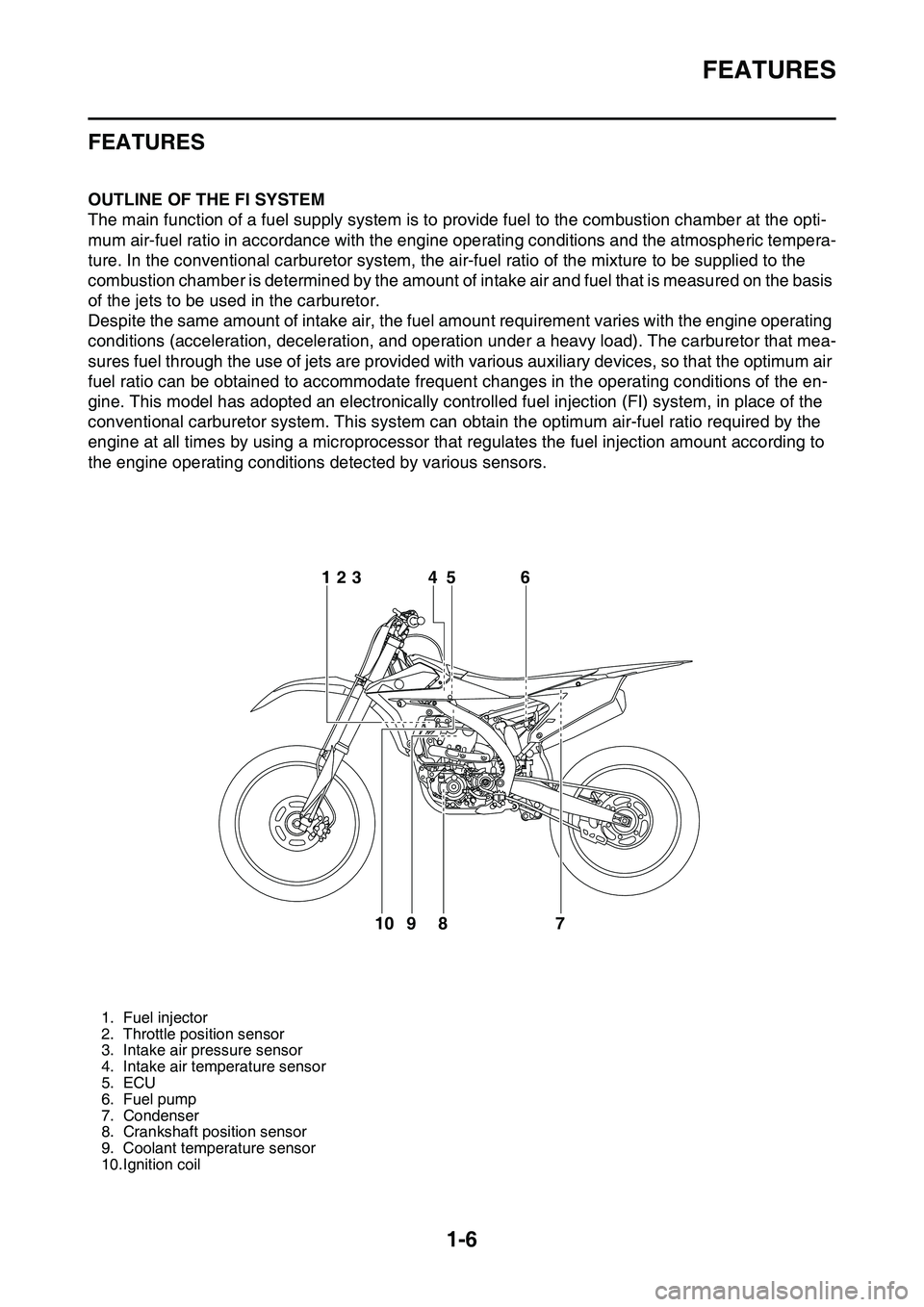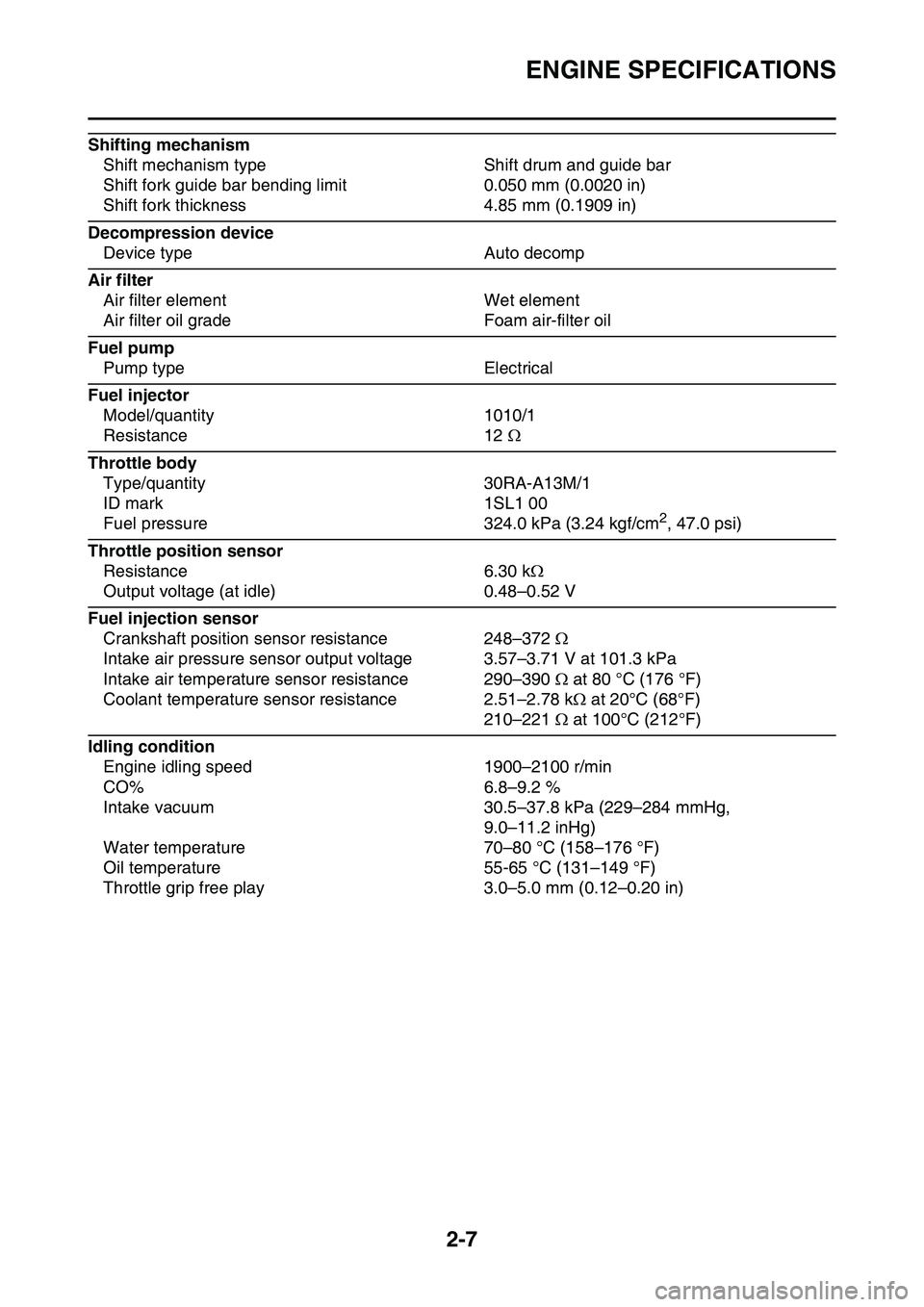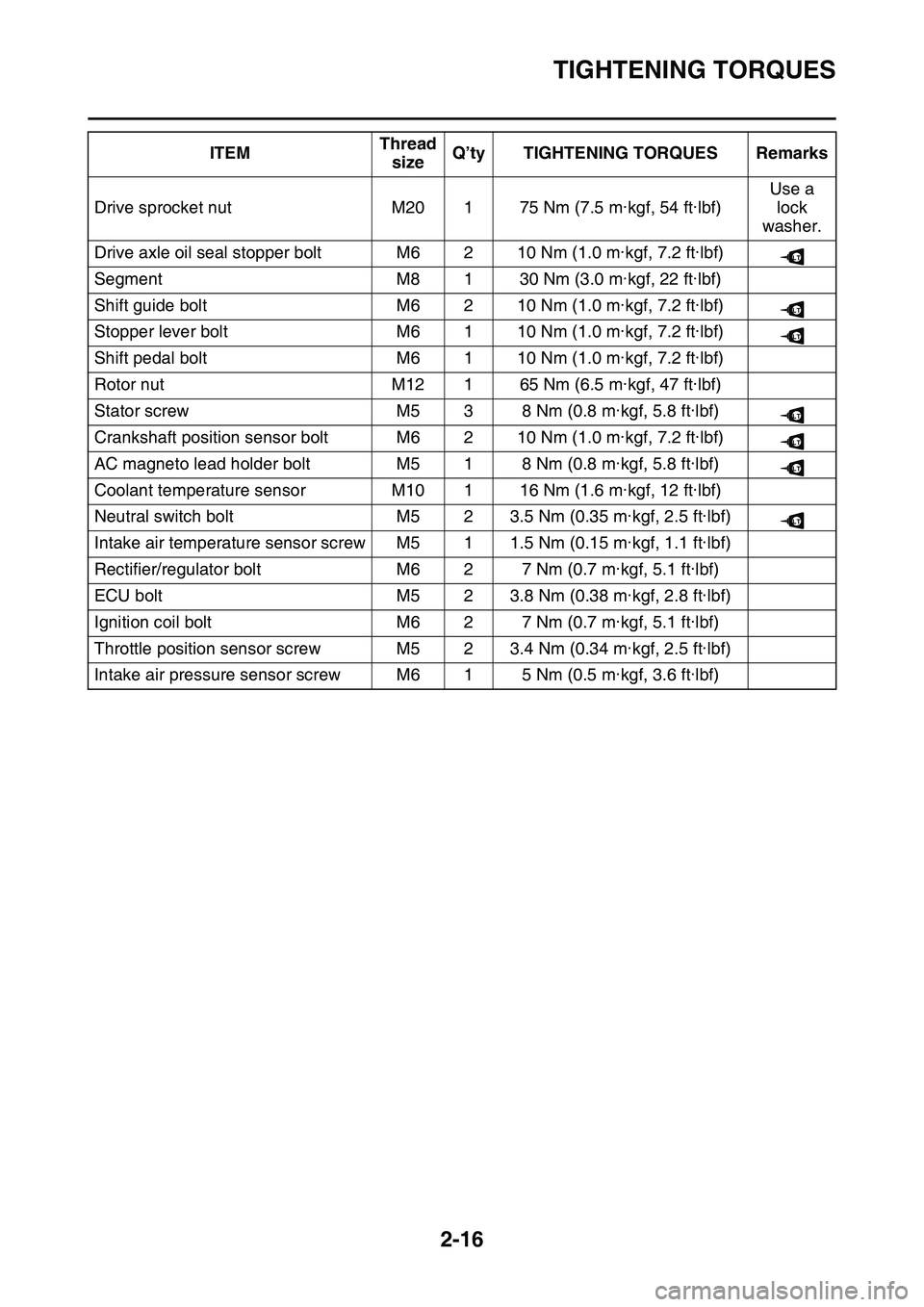2014 YAMAHA YZ450F oil temperature
[x] Cancel search: oil temperaturePage 20 of 360

FEATURES
1-6
EAS20170
FEATURES
EAS1SL1014OUTLINE OF THE FI SYSTEM
The main function of a fuel supply system is to provide fuel to the combustion chamber at the opti-
mum air-fuel ratio in accordance with the engine operating conditions and the atmospheric tempera-
ture. In the conventional carburetor system, the air-fuel ratio of the mixture to be supplied to the
combustion chamber is determined by the amount of intake air and fuel that is measured on the basis
of the jets to be used in the carburetor.
Despite the same amount of intake air, the fuel amount requirement varies with the engine operating
conditions (acceleration, deceleration, and operation under a heavy load). The carburetor that mea
-
sures fuel through the use of jets are provided with various auxiliary devices, so that the optimum air
fuel ratio can be obtained to accommodate frequent changes in the operating conditions of the en
-
gine. This model has adopted an electronically controlled fuel injection (FI) system, in place of the
conventional carburetor system. This system can obtain the optimum air-fuel ratio required by the
engine at all times by using a microprocessor that regulates the fuel injection amount according to
the engine operating conditions detected by various sensors.
EAS1SL1015
1. Fuel injector
2. Throttle position sensor
3. Intake air pressure sensor
4. Intake air temperature sensor
5. ECU
6. Fuel pump
7. Condenser
8. Crankshaft position sensor
9. Coolant temperature sensor
10.Ignition coil
6
7 8 95 4 123
10
Page 50 of 360

ENGINE SPECIFICATIONS
2-7
Shifting mechanism
Shift mechanism type Shift drum and guide bar
Shift fork guide bar bending limit 0.050 mm (0.0020 in)
Shift fork thickness 4.85 mm (0.1909 in)
Decompression device
Device type Auto decomp
Air filter
Air filter element Wet element
Air filter oil grade Foam air-filter oil
Fuel pump
Pump type Electrical
Fuel injector
Model/quantity 1010/1
Resistance 12
Throttle body
Type/quantity 30RA-A13M/1
ID mark 1SL1 00
Fuel pressure 324.0 kPa (3.24 kgf/cm2, 47.0 psi)
Throttle position sensor
Resistance 6.30 k
Output voltage (at idle) 0.48–0.52 V
Fuel injection sensor
Crankshaft position sensor resistance 248–372
Intake air pressure sensor output voltage 3.57–3.71 V at 101.3 kPa
Intake air temperature sensor resistance 290–390 at 80 °C (176 °F)
Coolant temperature sensor resistance 2.51–2.78 k at 20°C (68°F)
210–221 at 100°C (212°F)
Idling condition
Engine idling speed 1900–2100 r/min
CO% 6.8–9.2 %
Intake vacuum 30.5–37.8 kPa (229–284 mmHg,
9.0–11.2 inHg)
Water temperature 70–80 °C (158–176 °F)
Oil temperature 55-65 °C (131–149 °F)
Throttle grip free play 3.0–5.0 mm (0.12–0.20 in)
Page 59 of 360

TIGHTENING TORQUES
2-16
Drive sprocket nutM20175 Nm (7.5 m·kgf, 54 ft·lbf)
Use a
lock
washer.
Drive axle oil seal stopper boltM6210 Nm (1.0 m·kgf, 7.2 ft·lbf)
SegmentM8130 Nm (3.0 m·kgf, 22 ft·lbf)
Shift guide boltM6210 Nm (1.0 m·kgf, 7.2 ft·lbf)
Stopper lever boltM6110 Nm (1.0 m·kgf, 7.2 ft·lbf)
Shift pedal boltM6110 Nm (1.0 m·kgf, 7.2 ft·lbf)
Rotor nutM12165 Nm (6.5 m·kgf, 47 ft·lbf)
Stator screwM538 Nm (0.8 m·kgf, 5.8 ft·lbf)
Crankshaft position sensor boltM6210 Nm (1.0 m·kgf, 7.2 ft·lbf)
AC magneto lead holder boltM518 Nm (0.8 m·kgf, 5.8 ft·lbf)
Coolant temperature sensorM10116 Nm (1.6 m·kgf, 12 ft·lbf)
Neutral switch boltM523.5 Nm (0.35 m·kgf, 2.5 ft·lbf)
Intake air temperature sensor screwM511.5 Nm (0.15 m·kgf, 1.1 ft·lbf)
Rectifier/regulator boltM627 Nm (0.7 m·kgf, 5.1 ft·lbf)
ECU boltM523.8 Nm (0.38 m·kgf, 2.8 ft·lbf)
Ignition coil boltM627 Nm (0.7 m·kgf, 5.1 ft·lbf)
Throttle position sensor screwM523.4 Nm (0.34 m·kgf, 2.5 ft·lbf)
Intake air pressure sensor screwM615 Nm (0.5 m·kgf, 3.6 ft·lbf)
ITEMThread
sizeQ’ty TIGHTENING TORQUES Remarks
LT
LT
LT
LT
LT
LT
LT
Page 104 of 360

ENGINE
3-16
7. Pour the specified amount of engine oil into
the oil filler cap hole.
8. Install:
• Oil filler cap
9. Check:
• Oil level
Refer to “CHECKING THE ENGINE OIL
LEVEL” on page 3-14.
10.Check:
• Engine oil pressure
▼▼▼▼▼▼▼▼▼▼▼▼▼▼▼▼▼▼▼▼▼▼▼▼▼▼▼▼▼▼▼▼
a. Slightly loosen the oil pressure check bolt
“1.”
EWA
WARNING
When the engine is started with the check
bolt removed, oil will spout; therefore, al
-
ways loosen it before the checkup.
Start the engine and keep it idling until oil
starts to seep from the oil pressure check
bolt.
EWA
WARNING
Always keep the engine idling speed during
the checkup without increasing the engine
speed.
ECA
NOTICE
If no engine oil seeps out after one minute,
immediately turn the engine off so it will not
seize.
b. If no engine oil seeps out, check the engine
oil for leaks, and the engine oil passage and
the oil pump for damage.
c. Check the oil pressure again.
d. Tighten the oil pressure check bolt.
▲▲▲▲▲▲▲▲▲▲▲▲▲▲▲▲▲▲▲▲▲▲▲▲▲▲▲▲▲▲▲▲
EAS1SL1087ADJUSTING THE ENGINE IDLING SPEED
TIP
• Because the air pressure is lower at high alti-
tudes, the air-fuel mixture will become richer.
If the idling speed is low, turn the starter knob/
idle screw a few clicks counterclockwise to in
-
crease the speed before the adjustment.
• Before adjusting the engine idling speed,
make sure that the air filter element is not
clogged, the engine compression is proper,
and the throttle grip free play is proper.
• Adjust the engine idling speed with the starter
knob/idle screw pushed in completely.
1. Start the engine, and warm this up until the
oil has reached the specified temperature.
2. Attach the pocket tester with temperature
probe “1” to the oil drain bolt.
3. Install:
• Digital tachometer
Engine oil quantity
With oil filter element replace-
ment
0.69 L (0.73 US qt, 0.61 Imp.qt)
Quantity (disassembled)
0.95 L (1.00 US qt, 0.84 Imp.qt)
1
Oil pressure check bolt
10 Nm (1.0 m·kgf, 7.2 ft·lbf)
Oil temperature
55-65 °C (131–149 °F)
Digital tachometer
90890-06760
YU-39951-B
T R..
1
Page 105 of 360

ENGINE
3-17
TIP
Get the high tension cord “1” of the ignition coil
pinched in the detector “a” of the digital tachom
-
eter.
4. Measure:
• Engine idling speed
Out of specification Regulate.
5. Adjust:
• Engine idling speed
▼▼▼▼▼▼▼▼▼▼▼▼▼▼▼▼▼▼▼▼▼▼▼▼▼▼▼▼▼▼▼▼
a. Turn the starter knob/idle screw “1” in the di-
rection of “a” or “b” to make an adjustment.
▲▲▲▲▲▲▲▲▲▲▲▲▲▲▲▲▲▲▲▲▲▲▲▲▲▲▲▲▲▲▲▲
EAS1SL1088ADJUSTING THE VALVE CLEARANCE
TIP
• This section is intended for those who have
basic knowledge and skill concerning the ser
-
vicing of Yamaha motorcycles (e.g., Yamaha
dealers, service engineers, etc.). Those who
have little knowledge and skill concerning ser
-
vicing are requested not to undertake inspec-
tion, adjustment, disassembly, or reassembly
only by reference to this manual. It may lead to servicing trouble and mechanical damage.
• Make sure that the valve clearance is
checked or adjusted while the engine is cold
(at room temperature).
• While the valve clearance is checked or ad-
justed, make sure that the piston is positioned
in the top dead center (TDC).
1. Remove:
• Seat
• Side cover (left/right)
• Air scoop (left/right)
Refer to “GENERAL CHASSIS” on page 4-
1.
• Fuel tank
Refer to “FUEL TANK” on page 7-1.
•ECU
2. Remove:
• Spark plug
• Cylinder head cover
Refer to “CAMSHAFT” on page 5-11.
3. Remove:
• Timing mark accessing screw “1”
• Crankshaft end accessing screw “2”
• O-ring
4. Check:
• Valve clearance
Out of specification Regulate.
▼▼▼▼▼▼▼▼▼▼▼▼▼▼▼▼▼▼▼▼▼▼▼▼▼▼▼▼▼▼▼▼
a. Turn the crankshaft counterclockwise with a
wrench.
b. Align the top dead center (TDC) mark “a” on
the rotor with the alignment mark “b” on the
crankcase cover.
Engine idling speed
1900–2100 r/min
Direction “a”Engine idling speed De-
creases.
Direction “b”Engine idling speed In-
creases.
1 1
a a
1 b
a
Valve clearance (cold)
Exhaust
0.20–0.25 mm (0.0079–0.0098 in)
1
2
Page 198 of 360

ENGINE REMOVAL
5-3
Removing the electronic parts
OrderPart nameQ’tyRemarks
Use a suitable stand to raise the front wheel
off the ground.
SeatRefer to “GENERAL CHASSIS” on page 4-1.
Side cover (left/right)Refer to “GENERAL CHASSIS” on page 4-1.
Air scoop (left / right)Refer to “GENERAL CHASSIS” on page 4-1.
Fuel tankRefer to “FUEL TANK” on page 7-1.
Air filter case cover
1Rectifier/regulator1
2ECU1
3Ignition coil1
4Condenser1
5Neutral switch1
6AC magneto lead1Disconnect.
7Crankshaft position sensor coupler1Disconnect.
8Coolant temperature sensor coupler1Disconnect.
For installation, reverse the removal proce-dure.
T.R.
T.R.
T.R.T.R.
8 3
7
6
154
2
LT
Page 214 of 360

CYLINDER HEAD
5-19
EAS1SL1214
CYLINDER HEAD
Removing the cylinder head
OrderPart nameQ’tyRemarks
SeatRefer to “GENERAL CHASSIS” on page 4-1.
Side cover (left/right)Refer to “GENERAL CHASSIS” on page 4-1.
Air scoop (left / right)Refer to “GENERAL CHASSIS” on page 4-1.
Fuel tankRefer to “FUEL TANK” on page 7-1.
Exhaust pipe and silencerRefer to “ENGINE REMOVAL” on page 5-1.
Radiator hoseDisconnect.
Coolant temperature sensor couplerDisconnect.
Throttle bodyRefer to “THROTTLE BODY” on page 7-5.
CamshaftRefer to “CAMSHAFT” on page 5-11.
Upper engine bracketRefer to “ENGINE REMOVAL” on page 5-1
1Bolt (cylinder head)2
2Bolt (cylinder head)4
3Cylinder head1
4Cylinder head gasket1
5Timing chain guide (intake side)1
6Oil check bolt2
7 66
1st
2nd
Final20 Nm (2.0 m
kgf, 14 ftIbf)T.
R.
30 Nm (3.0 mkgf, 22 ftIbf)
10 Nm (1.0 mkgf, 7.2 ftIbf)T.R.
10 Nm (1.0 mkgf, 7.2 ftIbf)T.R.
15 Nm (1.5 mkgf, 11 ftIbf)T.
R
.
Page 284 of 360

THROTTLE BODY
7-5
EAS1SL1314
THROTTLE BODY
Removing the throttle body
OrderPart nameQ’tyRemarks
SeatRefer to “GENERAL CHASSIS” on page 4-1.
Side cover (left/right)Refer to “GENERAL CHASSIS” on page 4-1.
Air scoop (left/right)Refer to “GENERAL CHASSIS” on page 4-1.
Fuel tankRefer to “FUEL TANK” on page 7-1.
ECURefer to “ENGINE REMOVAL” on page 5-1.
Ignition coilRefer to “ENGINE REMOVAL” on page 5-1.
1Intake air temperature sensor coupler1Disconnect.
2Air filter case1
3Fuel injector coupler1Disconnect.
4Intake air pressure sensor coupler1Disconnect.
5Throttle position sensor coupler1Disconnect.
6Throttle cable cover1
7Throttle cable2
8Fuel hose1
9Exhaust pipe bracket1
2
1
6
10
11
9
8
3
7
5
4
3.5 Nm (0.35 mkgf, 2.5 ftIbf)T.R.
3.5 Nm (0.35 mkgf, 2.5 ftIbf)T.R.
7 Nm (0.7 mkgf, 5.1 ftIbf)T.R.
3.0 Nm (0.30 mkgf, 2.2 ftIbf)T.R.
10 Nm (1.0 mkgf, 7.2 ftIbf)T.R.